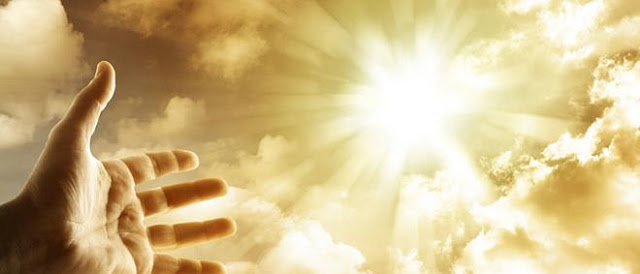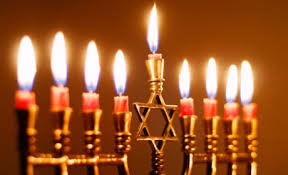 |
| Jesus Christ the Light of the World |
Christmas is known as the "feast of light",
as
Jesus, the Light of the World,
the Rising Dawn, the Light
to be revealed to the
Nations (Luke 2, 32), is born.
Those of the Jewish faith annually celebrate in December the
anniversary of the Re-dedication of the Temple as a "feast of lights"
(Hanukkah). Christians have made the Nativity their feast of lights in honor of
Him who was born as a Light to illuminate the nations (Luke 2, 32).
In medieval times it was customary to represent Christ the
Lord by a burning candle. This custom is still preserved in the liturgy of the
Church, as for instance, the Easter candle, the last candle at the Tenebrae
services of Holy Week. At Christmas, a large candle symbolizing the Lord used
to be set up in the homes of the faithful on the eve of the Feast. It was
placed in the center of a laurel wreath and kept burning through the Holy
Night, and was lit, thereafter, every night during the holy season.
The custom of the Christmas candle is still kept in its
original form in some countries. In Ireland, the mother or the father of the
household lights a holly-bedecked large candle on Christmas eve while the
entire family prays for all its dear ones, both living and departed. Among the
Slavic nations (Poles, Ukrainians, Russians) the large Christmas candle is put
on the table after it has been blessed by the priest in church. The Ukrainians
do not use candlesticks but stick the candle in a loaf of bread.
| Weihnachtspyramide |
In many sections of South America the candle is placed in a
paper lantern with Christmas symbols and pictures of the Nativity decorating
its sides. In England and France the Christmas light often consisted of three
individual candles molded together at the base, in honor of the holy Trinity.
In Germany the Christmas candle used to be placed on top of a wooden pole
decorated with evergreens (Lichtstock), or sometimes many smaller candles were
distributed on the shelves of a wooden structure made in the form of a pyramid,
adorned with fir twigs or laurel, draped with glittering tinsel
(Weihnachtspyramide). (During the seventeenth and eighteenth century this
pyramid was replaced by our Christmas tree.)
In addition to the main candle, it later became a custom to
set up other smaller candles all through the house in honor of the Feast:
Then be ye glad, good people,
This night of all the year,
And light ye up your candles:
His Star is shining near.
 |
| Candle in the window |
The customs of placing lighted candles in the windows at
Christmas was brought to America by the Irish. The historical background of
this custom is interesting. When religion was suppressed through Ireland during
the English persecution, the people had no churches. Priests hid in forests and
caves and secretly visited the farms and homes to say Mass there during the
night. It was the dearest wish of every Irish family that at least once in
their lifetimes a priest would arrive at Christmas to celebrate the Divine
sacrifice during Holy Night. For this grace they hoped and prayed all through
the year. When Christmas came, they left their doors unlocked and placed
burning candles in the windows so that any priest who happened to be in the
vicinity could be welcomed and guided to their home through the dark night.
Silently he entered through the unlatched door and was received by the devout
with fervent prayers of gratitude and tears of happiness that their home was to
become a church during Holy Night.
To justify this practice in the eyes of the English
soldiers, the Irish people used to explain: "We burn the candles and keep
the doors unlocked, that Mary and Joseph, looking for a place to stay, will
find their way to our home and be welcomed with open doors and open
hearts." The English authorities, finding this Irish "superstition"
harmless, did not bother to suppress it. The candles in the windows have always
remained a cherished practice of the Irish, although many of them have long
since forgotten the earlier significance. The custom was brought to this
country in the early nineteenth century and spread throughout the land, so much
so that in recent years electric candles and lights of all kinds are used in
homes and in public squares during the Christmas season. Business districts as
well as suburban streets spend much time and money to make their decorations
gay and bright with lights.
 |
| Feast of Lights Switzerland |
An inspiring and colorful sight are the Christmas fires
burned on the peaks of the Alps in Central Europe. Like flaming stars they hang
in the dark heavens during Holy Night, burning brightly and silently, as the
farmers from around the mountain-sides walk through the winter night down into
the valley for midnight Mass. Each person carries a lantern, swinging it to and
fro; the night seems alive with hundreds of glow-worms converging toward the
great light at the foot of the mountain — the parish church — shining and
sparkling, a "Feast of Lights," indeed. No one who has witnessed this
scene on Christmas Eve in Austria, Bavaria, or Switzerland will ever forget it.
A seasonable Christmas in England and Northern Europe is a
cold one. In past centuries it was even colder than it is now because the
"old Christmas" — before Pope Gregory XIII corrected the Julian
calendar in the sixteenth century — came eleven days later, on January fifth of
the present calendar.
At a time when coal and other modern heating fuels were
unknown, the firewood to be burned during Holy Night and on Christmas assumed
special significance. A huge log was selected and brought to the house with
great ceremony in preparation for the ceremony. It was called the
"Christmas log" or "Yule log," as Herrick sings:
 |
| Yule Log |
Come, bring with a noise,
My merrie, merrie boyes,
The Christmas Log to the firing. . . .
In some places the Yule log was the whole trunk of a tree,
carefully selected on the preceding feast of Candlemas and stored away to dry
out during the summer. Many popular customs and ceremonies were connected with
the Christmas log. The unburnt parts, for instance, were put aside and
preserved because the new log of next year had to be kindled with wood from the
old one. The main purpose of the log, however, was to blaze and burn on the
open hearth during Holy Night and on Christmas day.
In spite of modern heating today the Yule log has survived
in many homes in England and America as an old and cherished Christmas
tradition, though actually it originated among the Germanic tribes as a pagan
celebration for the Yule-god Thor at the time of the solstice.
Activity Source: Christmas Book, The by Francis X. Weiser,
S.J., Harcourt, Brace and Company, New York, 1952
Taken from website Catholic Culture

No comments:
Post a Comment